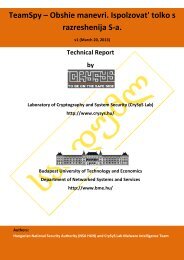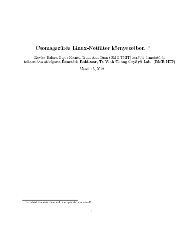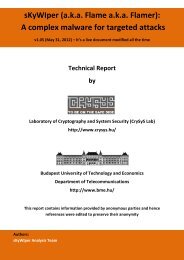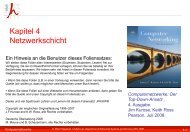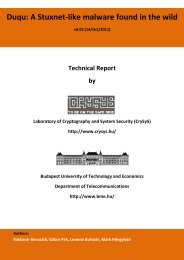FIREMAN: A Toolkit for FIREwall Modeling and ANalysis
FIREMAN: A Toolkit for FIREwall Modeling and ANalysis
FIREMAN: A Toolkit for FIREwall Modeling and ANalysis
You also want an ePaper? Increase the reach of your titles
YUMPU automatically turns print PDFs into web optimized ePapers that Google loves.
fully to discover security <strong>and</strong> reliability bugs in large programs<br />
[7,11], where it examines the control-flow <strong>and</strong>/or the<br />
data-flow to determine if a program satisfies user-specified<br />
properties without running the program. A firewall configuration<br />
is a specialized program, so it is natural to apply<br />
static analysis to check firewall rules. Compared to testing,<br />
static analysis has three major advantages: (1) it can<br />
proactively discover <strong>and</strong> remove serious vulnerabilities be<strong>for</strong>e<br />
firewalls are deployed; (2) it can discover all the instances<br />
of many known types of misconfigurations, because<br />
it can exhaustively examine every path in the firewall efficiently;<br />
(3) when multiple firewalls are deployed in a complex<br />
network topology <strong>and</strong> are subject to dynamic routing<br />
configurations, static analysis can discover vulnerabilities<br />
resulting from the interaction among these firewalls without<br />
the need to configure these routers.<br />
Testing has been proposed to discover firewall misconfigurations<br />
[3, 21, 27, 30], where a tool generates packets<br />
<strong>and</strong> examines whether a firewall processes these packets<br />
as intended. However, due to the enormous address space<br />
of packets, one cannot test all possible packets practically.<br />
Al-Shaer <strong>and</strong> Hamed describe common pairwise inconsistencies<br />
in firewall rules <strong>and</strong> propose an algorithm to detect<br />
these inconsistencise [1, 2]. Our work is inspired by them,<br />
but our tool can detect a much wider class of misconfigurations,<br />
such as inconsistencies <strong>and</strong> inefficiencies among<br />
multiple rules <strong>and</strong> security policy violations, <strong>and</strong> misconfigurations<br />
due to the interaction among multiple firewalls.<br />
To the best of our knowledge, our work is the first to apply<br />
rigorous static analysis techniques to real firewalls <strong>and</strong> to<br />
have found real misconfigurations.<br />
We have implemented our approach in the tool FIRE-<br />
MAN — <strong>FIREwall</strong> <strong>Modeling</strong> <strong>and</strong> <strong>ANalysis</strong>. <strong>FIREMAN</strong><br />
discovers two classes of misconfigurations: (1) violations<br />
of user-specified security policies — For example, allowing<br />
incoming packets to reach the TCP port 80 on an internal<br />
host violates the security policies of most networks;<br />
(2) inconsistencies <strong>and</strong> inefficiency among firewall rules,<br />
which indicate errors or warnings regardless of the security<br />
policies — For example, a rule intended to reject a packet<br />
is shadowed by a preceding rule that accepts the packet.<br />
<strong>FIREMAN</strong> can discover problems not only in individual<br />
firewalls but also in a distributed set of firewalls that collectively<br />
violate a security policy.<br />
We summarize our major contributions as follows:<br />
1. We give a comprehensive classification of firewall misconfigurations<br />
<strong>for</strong> both single firewalls <strong>and</strong> distributed<br />
firewalls (Section 3);<br />
2. We present a static analysis algorithm to examine firewall<br />
rules <strong>for</strong> policy violations <strong>and</strong> inconsistencies<br />
at different levels: intra-firewall, inter-firewall, <strong>and</strong><br />
cross-path (Section 4);<br />
3. We provide an implementation of our algorithm in the<br />
tool <strong>FIREMAN</strong> based on binary decision diagrams<br />
(BDDs). Using <strong>FIREMAN</strong>, we have discovered previously<br />
unknown misconfigurations in production firewalls.<br />
(Section 5)<br />
The rest of this paper is organized as follows. Section 2<br />
describes the operational model of firewalls, which lays the<br />
foundation <strong>for</strong> static analysis <strong>and</strong> error detection. Section 3<br />
classifies misconfigurations into policy violations, inconsistencies,<br />
<strong>and</strong> inefficiencies. Section 4 presents our static<br />
analysis algorithm <strong>for</strong> checking firewall misconfigurations.<br />
Section 5 describes our implementation <strong>and</strong> evaluation of<br />
<strong>FIREMAN</strong>, <strong>and</strong> the previously unknown misconfigurations<br />
that <strong>FIREMAN</strong> discovered in production firewalls. Section<br />
6 reviews related work <strong>and</strong> Section 7 concludes this<br />
paper.<br />
2. <strong>Modeling</strong> Firewalls<br />
2.1. Models <strong>for</strong> Individual Firewalls<br />
Firewalls from different vendors may vary significantly<br />
in terms of configuration languages, rule organizations <strong>and</strong><br />
interaction between lists or chains. However, a firewall generally<br />
consists of a few interfaces <strong>and</strong> can be configured<br />
with several access control lists (ACLs). Both the ingress<br />
<strong>and</strong> egress of an interface can be associated with an ACL.<br />
If an ACL is associated to the ingress, filtering is per<strong>for</strong>med<br />
when packets arrive at the interface. Similarly, if an ACL is<br />
associated to the egress, filtering will be per<strong>for</strong>med be<strong>for</strong>e<br />
packets leave the interface.<br />
Each ACL consists of a list of rules. Individual rules<br />
can be interpreted in the <strong>for</strong>m 〈P, action〉, where P is a<br />
predicate describing what packets are matched by this rule<br />
<strong>and</strong> action describing the corresponding action per<strong>for</strong>med<br />
on the matched packets. Packets not matched by the current<br />
rule will be <strong>for</strong>warded to the next rule until a match is<br />
found or the end of the ACL is reached. At the end of an<br />
ACL, the default action will be applied. This is similar to<br />
an “if-elif-else” construct in most programming languages.<br />
Implicit rules vary on different firewall products. On Cisco<br />
PIX firewall <strong>and</strong> routers, the implicit rule at the end of an<br />
ACL denies everything. On Linux Netfilter, the implicit rule<br />
is defined by the policy of the chain.<br />
Note that what we have described is the so-called “firstmatching”<br />
ACLs. Some firewalls e.g. BSD Packet Filter,<br />
use last-matching ACLs, in which the decision applied to<br />
a packet is determined by the last matched rule. An ACL<br />
using last-matching can be converted to first-matching <strong>for</strong>m<br />
by re-ordering. In this paper, we assume every ACL uses<br />
first-matching.<br />
Traditional stateless firewalls treat each packet in isolation<br />
<strong>and</strong> check every packet against the ACL, which is com-



